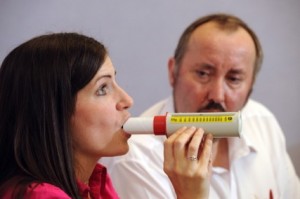You can expect several tests when you first attend the clinic for a diagnosis. The definitive diagnosis of bronchiectasis is through a CT scan of your lungs. This is the first essential test.
You will undergo a series of other tests to assess how well your lungs are working. These may include
-
-
Breathing tests – ‘spirometry tests’, which assess your breathing capacity (see spirometry video below).
- Measuring your oxygen levels in your body (blood oxygen levels)
-
You will be asked to produce a sample of sputum from the morning you attend the clinic. This is important in determining the severity of your condition and which antibiotics should be prescribed for future chest infections.
-
You will get blood tests to see if the doctors can work out why you have bronchiectasis though in around 50% no cause will be found. If a cause for the bronchiectasis is identified the treatment plan may be altered.
-
Given the range of tests it may take more than one visit to determine your diagnosis and to establish the correct treatment regime.
The above photo shows a breathing test called a peak flow test. This looks at the airflow in your lungs and is one of the tests used to determine how well your lungs are working.
Will I have all these tests every time I attend the clinic?
Not all the tests are needed at each visit. But you will need to bring a sputum sample and can also expect breathing tests, an assessment of blood oxygen levels and maybe blood tests at each visit.
You will get a chest x-ray once a year (more often if needed). Other tests may be taken on a less frequent basis at clinic visits.
You will also be asked the dates of when you had a chest infection needing antibiotics since your last visit. A wallet-sized bronchiectasis card is now available to record your chest infections and when they have occurred in the last 6 – 12 months (available at the bronchiectasis clinic).
Spirometry video from Cat Young on Vimeo.
Last Reviewed -1oth July 2019


